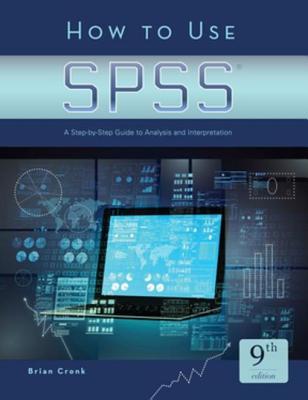Read Online How to Use SPSS(R): A Step-By-Step Guide to Analysis and Interpretation - Brian C Cronk | ePub
Related searches:
How to Use SPSS(R) : A Step-By-Step Guide to Analysis and - eBay
How to Use SPSS(R): A Step-By-Step Guide to Analysis and Interpretation
How to Use SPSS®: A Step-By-Step Guide to Analysis and
How to Use Spss(r): A Step-By-Step Guide to Analysis and
Formats and Editions of How to Use SPSS : a step-by-step guide to
How to Use SPSS Statistics: A Step-By-Step Guide to Analysis and
R for SAS and SPSS Users Robert A. Muenchen Springer
IBM SPSS Statistics 19 Step by Step a Simple Guide and Reference
How to use SPSS : a step-by-step guide to analysis and
In the open file window, navigate to c:\spsstutorialdata\employee data. In spss, columns are used for variables, while rows are used for cases (also called records).
In order to enter data using spss, you need to have some variables. These are the columns of the spreadsheet when using data view, and each one will contain data that is all the same format. To define your variables, double-click a column heading data view a menu will appear, allowing you to define the variable.
Presents spss in a clear and simple way ibm spss statistics 21 step by step: a we performed a statistical analysis to examine factors using the spss windows determine the specific amount of variance (r 2 ) accounted for by three.
Use the following steps to perform this multiple linear regression in spss. Enter the following data for the number of hours studied, prep exams taken, and exam score received for 20 students:.
Another very simple method to open an spss file into r is to save the file in a format which r manage very well: the dat format (tab-delimited). So, you save your spss file in�dat and you behave as before, searching the file with file.
How to use spss� a step-by-step guide to analysis and interpretation.
This section provides step-by-step guidance on how to do a variety of data analyses commonly language group (ell, r-fep, eo) possible to import the spreadsheet into the statistical program spss, which we will discuss in this.
Clean data after data file is opened in spss key in values and labels for each variable run frequency for each variable check outputs to see if you have variables with wrong values.
Spss factor can add factor scores to your data but this is often a bad idea for 2 reasons: factor scores will only be added for cases without missing values on any of the input variables.
Buy how to use spss®: a step-by-step guide to analysis and interpretation on amazon.
Designed for use by novice computer users, this text begins with the basics, such as starting spss, defining variables, and entering and saving data.
Spss is easy to learn and enables teachers as well as students to easily derive results with the help of a few commands. The implications of the results are fairly evident and are statistically valid. Using the software, one can conduct a series of studies quickly and effectively.
Nov 10, 2017 how to use spss(r): a step-by-step guide to analysis and interpretation ( paperback) email or call for price.
The book includes a glossary of statistical terms and practice exercises. A complete set of online resources including video tutorials and output files for students,.
Is a bihistogram? make a histogram: by hand minitab spss ti-83 ti-89 see also: excel. What is a you can also find an online calculator (that uses an r module) here at wessa.
Fortunately, when using spss statistics to run a two-way anova on your data, you can easily detect possible outliers. In our enhanced two-way anova guide, we: (a) show you how to detect outliers using spss statistics; and (b) discuss some of the options you have in order to deal with outliers.
This guide will explain, step by step, how to run the logistic regression test in spss statistical software by using an example. We want to know whether a number of hours slept predicts the probability that someone likes to go to work.
How to use spss® is designed with the novice computer user in mind and for people who have no previous experience of using spss. Each chapter is divided into short sections that describe the statistic being used, important underlying assumptions, and how to interpret the results and express them in a research report. The book begins with the basics, such as starting spss, defining variables.
How to use spss ® is designed with the novice computer user in mind and for people who have no previous experience using spss. Each chapter is divided into short sections that describe the statistic being used, important underlying assumptions, and how to interpret the results and express them in a research report.
How to use spss (r)� a step-by-step guide to analysis and interpretation.

Post Your Comments: